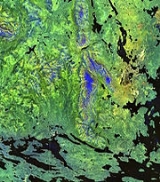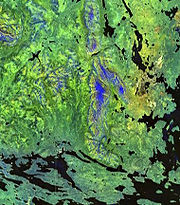
Lapland Biosphere Reserve
Encyclopedia

Lapland Biosphere Reserve is a zapovednik in Murmansk Oblast
Murmansk Oblast
Murmansk Oblast is a federal subject of Russia , located in the northwestern part of Russia. Its administrative center is the city of Murmansk.-Geography:...
, Russia
Russia
Russia or , officially known as both Russia and the Russian Federation , is a country in northern Eurasia. It is a federal semi-presidential republic, comprising 83 federal subjects...
, beyond the Arctic Circle
Arctic Circle
The Arctic Circle is one of the five major circles of latitude that mark maps of the Earth. For Epoch 2011, it is the parallel of latitude that runs north of the Equator....
, occupying an area of 2,784 km² (1,075 sq mi) to the northwest of Lake Imandra
Lake Imandra
Imandra is a lake in the south-western part of the Kola Peninsula in Murmansk Oblast, Russia, slightly beyond the Arctic circle. It is located 127 m above sea level; its area is about 876 km², maximum depth is 67 m. The shape of the shore line is complicated. There are a number of islands and the...
, including 86 km² of inland water. Most of the territory is covered by northern taiga
Taiga
Taiga , also known as the boreal forest, is a biome characterized by coniferous forests.Taiga is the world's largest terrestrial biome. In North America it covers most of inland Canada and Alaska as well as parts of the extreme northern continental United States and is known as the Northwoods...
and montane tundra
Tundra
In physical geography, tundra is a biome where the tree growth is hindered by low temperatures and short growing seasons. The term tundra comes through Russian тундра from the Kildin Sami word tūndâr "uplands," "treeless mountain tract." There are three types of tundra: Arctic tundra, alpine...
with the highest point on Mount Ebruchorr (1115 m a.s.l.).
The Lapland Nature Reserve was established in 1930. However, in 1951 along with many other zapovedniks of the Soviet Union
Soviet Union
The Soviet Union , officially the Union of Soviet Socialist Republics , was a constitutionally socialist state that existed in Eurasia between 1922 and 1991....
it was abolished. It was reestablished in 1957, but in 1961-1965 was merged to Kandalaksha Nature Reserve. In 1983 the 1,613 km² area of the Lapland Nature Reserve was significantly expanded to include 1,296 km² of territories to the northwest, farther from the polluting influence of the Monchegorsk
Monchegorsk
Monchegorsk is a town in Murmansk Oblast, Russia, located on the Kola Peninsula, south of Murmansk, the administrative center of the oblast. Administratively, it is incorporated as Monchegorsk Town with Jurisdictional Territory—a unit of administrative division equal in status to that of a district...
nickel
Nickel
Nickel is a chemical element with the chemical symbol Ni and atomic number 28. It is a silvery-white lustrous metal with a slight golden tinge. Nickel belongs to the transition metals and is hard and ductile...
smelter, and the zapovednik gave away 124 km² near the city. Since 1985 the zapovednik has been designated by UNESCO
UNESCO
The United Nations Educational, Scientific and Cultural Organization is a specialized agency of the United Nations...
as a biosphere reserve
Biosphere reserve
The Man and the Biosphere Programme of UNESCO was established in 1971 to promote interdisciplinary approaches to management, research and education in ecosystem conservation and sustainable use of natural resources.-Development:...
.
The reserve has a subarctic climate
Subarctic climate
The subarctic climate is a climate characterized by long, usually very cold winters, and short, cool to mild summers. It is found on large landmasses, away from the moderating effects of an ocean, generally at latitudes from 50° to 70°N poleward of the humid continental climates...
(Köppen's
Köppen climate classification
The Köppen climate classification is one of the most widely used climate classification systems. It was first published by Crimea German climatologist Wladimir Köppen in 1884, with several later modifications by Köppen himself, notably in 1918 and 1936...
Dfc). However, it is free of permafrost
Permafrost
In geology, permafrost, cryotic soil or permafrost soil is soil at or below the freezing point of water for two or more years. Ice is not always present, as may be in the case of nonporous bedrock, but it frequently occurs and it may be in amounts exceeding the potential hydraulic saturation of...
. The predominant tree species are Pinus sylvestris subsp. lapponica, Picea obovata, Betula pendula, B. pubescens subsp. subarctica and B. pubescens subsp. tortuosa. Among animals, wild reindeer
Reindeer
The reindeer , also known as the caribou in North America, is a deer from the Arctic and Subarctic, including both resident and migratory populations. While overall widespread and numerous, some of its subspecies are rare and one has already gone extinct.Reindeer vary considerably in color and size...
has been the main subject to studies and protection.
External links
- Official site (in Russian)
- Laplandskiy Biosphere Reserve @ UNESCO - MAB Biosphere Reserves Directory

